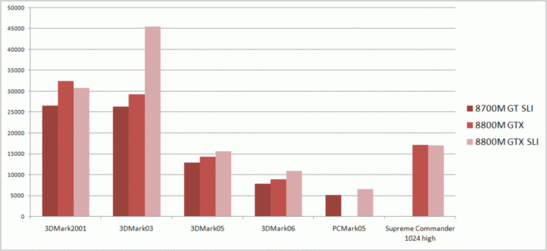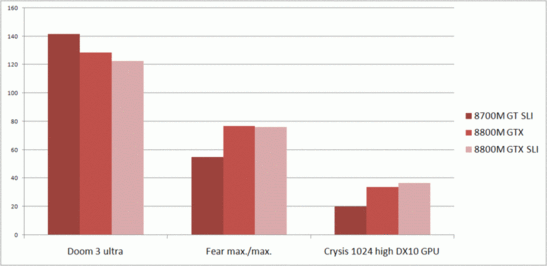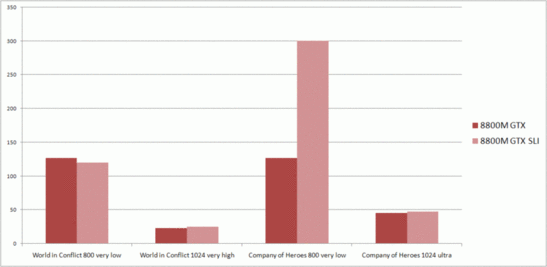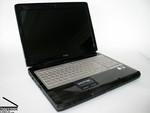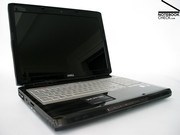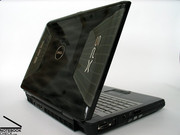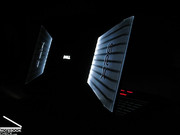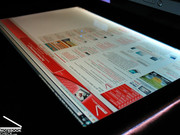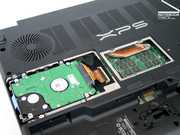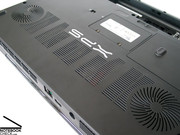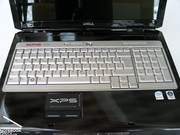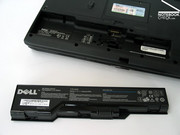Review Dell XPS M1730 with 8800M GTX SLI
Double Core.
The XPS M1730 is now also available with two GeForce 8800M GTX SLI video cards for a surcharge of 490,- respectively 780,- Euro. Hence, Dell upgrades its signature gaming notebook with the newest and at the time of writing fastest video technology. This review uncovers, how these new video cards impact on performance and emissions and whether they are worth the surcharge.
Case
Dell didn't modify the big case of the XPS M1730 in any way since the upgrade with 8800M GTX SLI video card. Features like LED backlight, additional display for gaming, and striking design are the same. Also the robust workmanship did not change. So, we refer to the review of the XPS M1730 with 8700M GT SLI for a detailed discussing of these aspects.
Input Devices
Dell also didn't modify the good input devices too, so we'd like to refer to the former review regarding this aspect too. Typing with the illuminated keyboard is user-friendly. However, you can fatigue when typing for a long time. The touch pad once again proved to work precisely.
>> Description of the input devices of the former Dell XPS M1730 review
Display
This test sample was also equipped with 1920x1200 pixels 17" WUXGA panel with reflecting surface. The average brightness of 220 cd/m² is similarly good than the one of the former M1730 (compare with 213cd/m² of the former review). However, when displaying a black picture, a visible uneven illumination got obvious at once.
Despite its good brightness the display reflects heavily in bright environments (rising sun in the office). So, it is to our opinion not fit for daily work. However, because of its good maximum contrast of above 640:1, it's a nice computer for gaming sessions or watching motion pictures in the evening.
A detailed discussing of the viewing angles (including video), colour representation, and speed of reaction is available in the former review of the XPS M1730.
| |||||||||||||||||||||||||
Brightness Distribution: 72 %
Contrast: 625:1 (Black: 0.4 cd/m²)
Performance
Finally we come to the most important innovation, the performance of the two built-in Nvidia GeForce 8800M GTX connected by SLI bridge. At the time of our review this video solution was supported by an "old" Core 2 Duo T7700, because the new Penryn Core 2 Duo CPUs weren't built-in at that time. Now, the M1730 is only available with Penryn CPU.
Compared with the 8700M GT SLI solution the 8800M video card is really better. Actually its performance is up to 109% higher (Lightsmark 2004), in average it is about 44% higher, so, this is a clear improvement. Only the performance of Doom3 with ultra details is 13% worse (however, 122 fps are still very good) compared with the 8700M GT. This might be due to the clearly higher clock rate of the 8700M GT (obviously the bigger number of pipelines is not crucial for Doom 3).
Compared to only a single 8800M GTX video card (if you deactivate SLI by the Nvidia system control), the artificial benchmarks of Futuremark only display a clear performance increase. The performance impact of deactivating SLI on games heavily depends on their support of SLI. World in Conflict, Crysis, and Company of Heroes profit from the second video card. Their performance is increased by 9%, 8%, and 4% (all of them with highest level of details). There was hardly any difference when running F.E.A.R. and Supreme Commander. And Doom3 was even slower with second video card.
The rest of the equipment is also better than the one of the former M1730, so this also slightly improves the overall performance. Two Seagate hard disks in RAID 0 connection, 4GB RAM (only 3.2 GB are accessible in Vista 32 Bit) and a T7700 processor (the former M1730 was equipped with a T7500) also contribute to the improved performance.
The performance for applications is, similar to the M1730 which was equipped with 8700M, excellent. Furthermore, the new Penryn processor should even improve it (see also our comprehensive Penryn comparison review).
| 3DMark 2001SE Standard | 30794 points | |
| 3DMark 03 Standard | 45520 points | |
| 3DMark 05 Standard | 15615 points | |
| 3DMark 06 Standard Score | 10824 points | |
Help | ||
World in Conflict
The integrated benchmark of World in Conflict shows a complex fight and should be an upper limit. We reviewed with the following settings: 1024x768 - high - DirectX 10 with an average of 31 fps. You can run this game smoothly at best with these settings.
| Resolution | Settings | min. | med | max |
|---|---|---|---|---|
| 800x600 | very low, DX 9 | 69 | 120 | 249 |
| 1024x768 | medium, DX 9 | 21 | 52 | 134 |
| 1024x768 | high, DX 10 | 15 | 31 | 90 |
| 1024x768 | very high, DX 10 | 10 | 25 | 57 |
| 1920x1200 | very high, DX 10 | 4 | 14 | 32 |
Call of Duty 4
This up-to-date shooter, proved to be playable in full HD resolution, i.e., 1920x1200 with an average of 88 fps. The minimum frame rate (Level 1) was 60 fps. So, you can enjoy this game without flickering - even on-line matches are possible.
Company of Heroes (1.7)
This real-time strategy game was according to its built-in benchmark only playable with a resolution of 1024x768 and high details (min:15, med:36, max 60 fps). A short test with a resolution of 1920x1200 displayed only 3 fps at a skirmish (with graphical errors), so, it is unplayable. Maybe improvements (by Nvidia) of the video driver could help here.
Unreal Tournament 3
This fast multi-player shooter had an excellent performance. It was, maybe due to the supported PhysX card, with a resolution of 1920x1200 and maximum details absolutely playable (30-60 fps, in average: 53 fps).
Age of Empires 3 - Asian Dynasties
The relatively demanding real-time strategy game by Microsoft demands especially for multi-player games much from CPU and video card. The review proved that the XPS M1730 is ready to cope with these demands. The game was well playable (20-60 fps) with the native resolution of 1920x1200 and all setting on high (except from the footprints). However, sometimes there were short interrupts (0 fps).
Doom 3
This shooter, which is based on OpenGL, is a classical scary shooter. It can be played with highest resolution and highest number of details.
| Doom 3 | |||
| Resolution | Settings | Value | |
| 1024x768 | Ultra, 0xAA, 0xAF | 116.3 fps | |
| 800x600 | High, 0xAA, 0xAF | 121.5 fps | |
| 640x480 | Medium, 0xAA, 0xAF | 125.1 fps | |
| 640x480 | Low, 0xAA, 0xAF | 125.2 fps | |
Quake 4
The same was true for Quake 4, which is based on Doom 3's engine. Even with the detail level 'ultra' it was possible to play smoothly with an average of 60 fps.
F.E.A.R.
Fear, another scary shooter, supports only DirectX 9. Even at a resolution of 1600x1200 and highest detail level it was possible to play Fear with an average of 56 fps.
| F.E.A.R. | |||
| Resolution | Settings | Value | |
| 1024x768 | GPU: max, CPU: max, 0xAA, 0xAF | 76 fps | |
| 800x600 | GPU medium, CPU medium, 0xAA, 0xAF | 84 fps | |
| 640x480 | GPU min, CPU min, 0xAA, 0xAF | 117 fps | |
Supreme Commander
The test of the CPU demanding Supreme Commander uncovered that the performance diminishes, the higher the number of players and the bigger the maps. In single-player mode and with small maps it was possible to enjoy playing Supreme Commander with a resolution of 1920x1200 and high number of details. However, with big multi-player maps, the game mostly flickers. The Core 2 Duo was clearly not sufficiently powerful.
Crysis
Today's most hardware demanding game, Crysis, was even a heavy load for the two 8800M GTX in SLI connection. The game was with a high detail level only reasonably playable with XGA resolution (in between it flickered time and again). You'll need to try different settings to find one which is most convenient for this game.
| Crysis - GPU Benchmark | |||
| Resolution | Settings | Value | |
| 1024x768 | High | 36.5 fps | |
Application performance
Due to two 200GB hard disks combined in a RAID 0 array the performance is very good for applications. This way the two 200 GB hard disk have a performance which is as good as the one of the currently fastest 3.5'' desktop hard disks, however, at the greater risk of data loss, and less capacity. So, the XPS should also be sufficiently powerful for demanding applications like video editing, image processing, and software development. If the intended field of operation is CAD or 3D rendering you should maybe prefer a notebook of the Precision series, which is equipped with certified video cards.
| PCMark 05 Standard | 6458 points | |
Help | ||
Emissions
Loudness
The impact of the new high-performance video cards on fan control is most obvious. Overall all measured values are higher than of the (nearly silent) M1730 with 8700M GT video card. Even if idle, the noise level of the fan is at least 34 dB (compare with the hardly audible 31.2 dB of the former review). This is about the level of other well-known DTR notebooks.
The maximum noise level of 45 dB also clearly exceed the 37.7 dB of the 8700M GT version. Despite being relatively loud, we didn't feel that the noise is obtrusive.
Noise level
| Idle |
| 34.2 / 35.8 / 40.5 dB(A) |
| HDD |
| 36.2 dB(A) |
| Load |
| 40.5 / 45.2 dB(A) |
 | ||
30 dB silent 40 dB(A) audible 50 dB(A) loud |
||
min: | ||
Temperature
The temperature emissions are very similar to the ones of the 8700M SLI Version. The fan, which runs more frequently and faster, compensates for the higher temperature emissions of the 8800M video cards, Therefore, the maximum surface temperature is 41.4°C, which is alright. The palm rest areas stay comfortably cool too, so, there is no impairment of serviceability caused by heat.
(±) The maximum temperature on the upper side is 41.4 °C / 107 F, compared to the average of 40.5 °C / 105 F, ranging from 21.2 to 68.8 °C for the class Gaming.
(+) The bottom heats up to a maximum of 39.7 °C / 103 F, compared to the average of 43.3 °C / 110 F
(+) The palmrests and touchpad are reaching skin temperature as a maximum (32.7 °C / 90.9 F) and are therefore not hot.
(-) The average temperature of the palmrest area of similar devices was 28.9 °C / 84 F (-3.8 °C / -6.9 F).
Speakers
There was also no difference regarding speakers compared with the former review. The sound of the four speakers is clear and good. Basses are audible, but, not as good as of notebooks with extra subwoofer. Overall the maximum volume is alright, however, it could be better for music or DVD playback.
Battery Runtime
As expected the battery runtime is indeed very short. During our review it ranges from 60 to nearly 90 minutes. In comparison with the 8700 GT SLI model, the maximum runtime, measured when idling with minimum brightness, and without wireless communication modules, fell from 110 to 86 minutes in our test.
Because the XPS is also very heavy and, therefore, not really mobile, the short battery runtime is not really crucial.
| Off / Standby | |
| Idle | |
| Load |
|
Key:
min: | |
Verdict
To summarize the Dell XPS M1730 does well. In our review all current games ran smoothly, most of them at highest detail level. The difference to the predecessor M1730 with 8700M GT SLI video solution is obvious at once. The improved performance causes higher noise emissions and costs essentially more.
Compared with a single 8800M GTX video card the performance increase is only small. Here you can only hope that the video driver will be improved (or that Dell also offers a model with only a single 8800M GTX video card besides one with a single 8700M GT. At the time of writing it is not reasonable to prefer the SLI solution compared to a single video card (however, you do not have the choice yet).
All other aspects of the XPS M1730 are the same as in our previous review, so, more details are available there. These are among others a good quality of the case, good input devices, and a reflecting display.
Summarizing the above the XPS M1730 is to be recommended for gamers, who focus on performance and less on price. Due to LED effects it will also attract attention on LAN parties.





